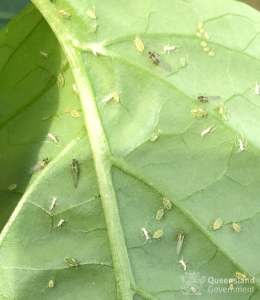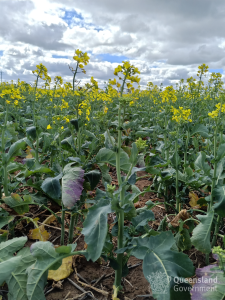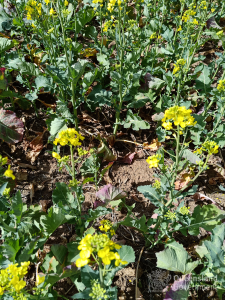More growers are planting canola in southern Queensland this season, so it’s important to be on the lookout for turnip yellows virus (TuYV) – one of the main viral threats to canola.
What is TuYV and why does it matter?

Green peach aphid is a vector for TuYV
TuYV is a persistent virus that affects canola and other brassica crops. It is transmitted by green peach aphids (GPA, Myzus persicae), that pick up the virus when feeding on infected plants and can then spread it throughout a crop – even if aphid numbers are low.
Because GPA can be present without obvious colonies, infection can occur before growers are even aware of an aphid issue. Once infected, plants remain infected for life.
Symptoms to look for

Purpling and cupping of affected leaves in TuYV infected canola.
Symptoms are often subtle, especially early in the season, but can include:
- Purpling or reddening of older leaves
- Discolored leaves become thick and may cup upwards
- Stunted growth or uneven development
- General loss of vigour
- Fewer flowers and seeds produced.
These symptoms can be easily confused with nutrient deficiencies or environmental stress, so it’s worth getting lab confirmation if you’re unsure.
Impact on yield

If infected early, plants can be stunted with reduced yield.
Early infection can lead to significant yield losses. In southern states, TuYV is considered one of the most damaging viral diseases in canola, with yield losses of up to 75% reported in severe outbreaks.
If plants get infected when they are older (post-flowering) they may show leaf symptoms but are generally less affected in relation to stunting and reduced yields.
Free TuYV testing available now
To support growers this season, free TuYV testing is available for canola plants and aphid samples collected from Queensland paddocks.
If you notice suspicious symptoms or suspect GPA activity, consider sending in samples for testing. Both plant and aphid samples can help build a clearer picture of virus spread across the region.
Sample collection tips
- Send at least 5 cm2 of leaf or a whole leaf of plants showing symptoms, and/or
- Collect live aphids attached to a leaf sample or remove them and put them in a sealed bag or container
- Include paddock location, crop stage, and contact details.
Express post is recommended to maintain sample integrity.
Questions or sample submissions?
If you’re seeing symptoms or have concerns about TuYV in your canola crop, contact Fiona Filardo at the Department of Primary Industries (DPI) Queensland:
📞 [07] 37088449 📧 [email protected]
This information and testing form part of the GRDC and QLD DPI-funded project DAW2305 – Effective virus management in grain crops. Photos by Fiona Filardo.
